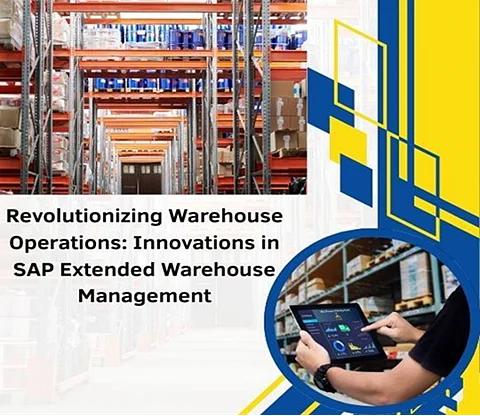

As e-commerce continues to develop at incredible speed, demand for quick, streamlined order fulfillment has placed warehouse management at the helm of this industry imperative. With the increasing demands of speed, accuracy, and cost, advanced cutting-edge solutions such as SAP Extended Warehouse Management (EWM) are revolutionizing warehouse operations. In his insightful paper, Parthiban Mohanasundaram discusses how SAP EWM is reshaping logistics through cutting-edge technologies that integrate automation, real-time data, and smart analytics.
SAP EWM greatly improves warehouse operations by easily integrating all EWM processes with ERP systems, increasing overall inventory accuracy, optimizing a warehouse’s storage space, and increasing order fulfillment efficiency. This seamless integration is especially important when orchestrating complex, multi-warehouse environments. When paired with automated storage and retrieval systems (AS/RS), warehouses implementing SAP EWM have recently experienced as much as a 23% increase in order processing efficiency and 30% savings in labor costs. Additionally, the system achieves a remarkable 99.8% picking accuracy rate, minimizing manual intervention and streamlining workflows.
Storage optimization within SAP EWM is more than just slots and docks. That’s why the system’s intelligent storage optimization tools increase space utilization as much as 35% through space optimization tools that automatically allocate storage spaces based on actual product demand using dynamic slotting algorithms. This is especially beneficial in high-throughput warehouses where quick order fulfillment is a priority.
Further, the system’s labor-saving feature of up to 27% less picking travel distance directly feeds into operational efficiency. With such intelligent storage strategies, businesses can handle a greater volume of goods without expanding physical warehouse space, thus improving both throughput and cost-efficiency.
SAP EWM transforms this process by tracking inventory in real time, guaranteeing businesses up to 98.5% inventory accuracy. It automatically syncs data between all the warehouses simultaneously, eliminating inventory variances, and lowering inventory holding costs by up to 23%. In today’s e-commerce-powered world, this level of precision is more important than ever, because real-time visibility into stock availability can make or break customer experiences. By minimizing errors and delays, SAP EWM enhances operational efficiency and helps businesses stay competitive while managing inventory more effectively.
SAP EWM improves workforce management with more efficient task assignment and workload balancing, and helps you get the most from your labor resources. Organizations utilizing its labor management functions have experienced 24% improvement in picking productivity and a 20% decrease in training time for new employees. By using real-time task assignments and skills-based routing, their systems increase the accuracy of orders by matching workers to tasks based on proclivities or expertise. This approach boosts operational efficiency and can reduce labor costs by up to 18%.
Successful yard management processes are important to keep tight operating schedules in big warehouse complex facilities. Further SAP EWM interfaces with yard management systems that can help external companies to optimize dock door and customs operations, increasing yard flow, decreasing truck turned-away rates, and overall dock utilization rates. Studies suggest that organizations implementing SAP EWM’s yard management have reduced truck waiting times by 32% and increased overall throughput by 23%. This level of coordination across the yard ensures that goods are loaded and unloaded in an efficient, timely manner, further improving overall supply chain performance.
Beyond helping New York City run more efficiently, SAP EWM has a positive impact on the environment. As industries and companies continue to implement greener processes, SAP EWM focus on optimizing resource usage aligns directly with sustainability initiatives. Research shows that implementing this system can lead to significant reductions in energy consumption and waste while also minimizing the need for paper-based processes.
By optimizing warehouse operations, SAP EWM helps organizations reduce their carbon footprint and operate in a more environmentally friendly manner, aligning with the growing trend of corporate responsibility in the logistics sector.
SAP EWM keeps its eyes firmly on the future, embracing the latest technologies such as AI, IoT, and blockchain. These innovations position SAP EWM as a future-ready solution for modern logistics challenges.
AI and machine learning capabilities, like those in Microsoft Azure, can help predict maintenance needs, optimize resource allocation and improve picking accuracy. With IoT integration, AI can keep a constant, real-time watch over inventory levels, environmental changes, and equipment status so all warehouses can run like well-oiled machines. Meanwhile, blockchain technology enhances supply chain transparency and security, providing end-to-end visibility for all stakeholders.
SAP Extended Warehouse Management is a ground-breaking multi-tenant, cloud warehouse management solution that combines automation, real time data and advanced, intelligent optimization to bring efficiency to warehouse operations. The system’s capabilities in inventory management, workforce optimization, and yard management are unmatched, driving significant improvements in operational efficiency and cost reduction.
Ultimately, as enterprises find themselves facing the new challenges brought about by increasingly complex supply chains, SAP EWM provides an integrated answer that equips businesses to meet the challenges of the evolving logistics landscape. Parthiban Mohanasundaram’s insightful perspective underscores the immensely important and transformative role this technology will have in the future of warehouse operations, helping companies stay relevant and on the cutting edge of sustainability as the world becomes ever more digital.
